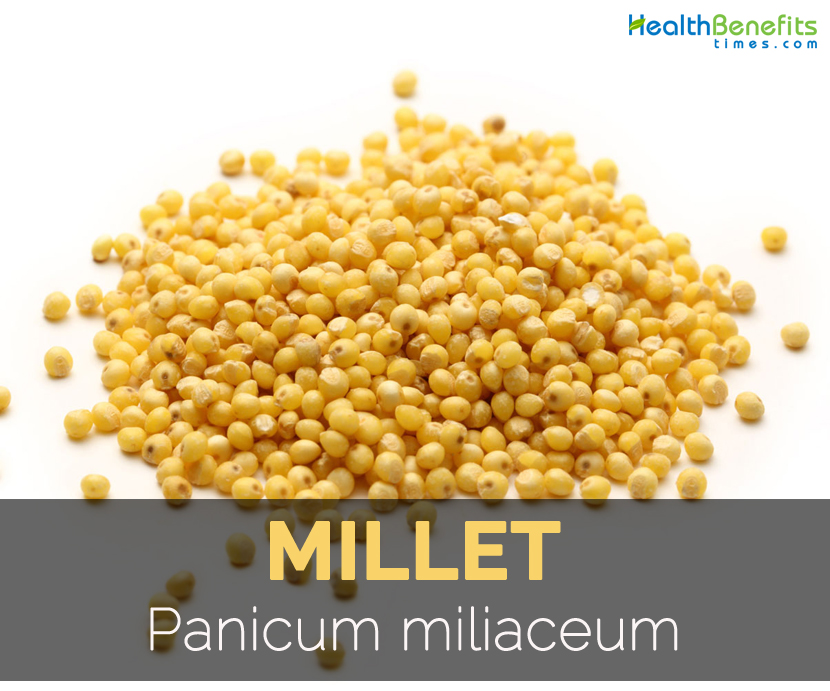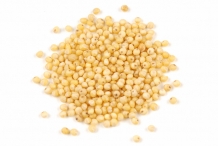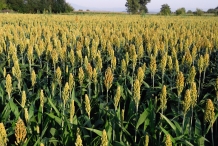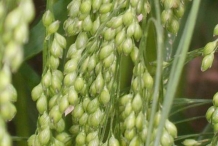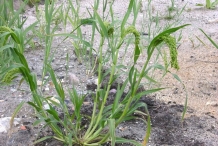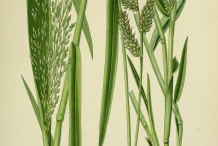Proso millet is native to Asia. Other names for the species include Proso millet, broomtail millet, common millet, red millet, hog millet, white millet, broomcorn millet, wild millet, panic millet, black seeded proso millet, hog millet and broom millet. It is known as ji in China; millet commun in French and borona in Spain.
History
Both domestication and wild ancestor of Proso millet is unknown but it emerged as a crop in China and Transcaucasia about 7,000 years before. It is still extensively cultivated in India, Russia, Ukraine, the Middle East, Turkey and Romania. In United States, Proso millet is widely cultivated for birdseed. Due to the low gluten content, it is sold as a health food. It could be consumed people who are not tolerable to wheat.
This millet is found in the Neolithic sites in Georgia and east in China. Proso millet reached Europe after it reached to Georgia. It firstly appeared in East and Central Europe. It was cultivated in the Near East in ruins of Nimrud, Iraq which dated about 700 BC.
It is domesticated in Manchuria and got introduced 3000 years ago to Europe. For the last 10,000 years, it was cultivated in the East Asia. Since 3000 BC, this millet was cultivated in China. Proso millet is extensively cultivated in Northern China, Korea, Mongolia, Southeastern Russia, Pakistan, Afghanistan, Southern Europe and India.
Plant
Proso millet is an annual grass with light green, erect, round or flattened stems which can reach a height of 20-60 inches (0.5-1.5 m) having 6-8 mm as a thickness. Leaves are bright green and 1 ft. (30 cm) long. It possesses glabrous grains that are white to reddish brown, ovoid or broad ellipsoid and 3 mm long. The small seeds are 2-3 mm or 0.1 inch in size and the color ranges from yellow, cream, orange to red or brown.
Nutritional Value
In a cup of 200 gm of raw Millet, it grants 17.34 g of water, 22.04 g of protein, 8.44 g of lipid fat, 6.5 g of ash, 145.7 g of carbohydrate and 17 g of total dietary fiber. The same serving size grants 166.67% of copper, 141.91% of manganese, 112.08% of carbohydrate, 81.43% of phosphorus, 75.76% of leucine, 75.25% of Iron, 70.17% of Vitamin B1, 59.08% of Vitamin B6, 59% of Vitamin B3, 55.62% of isoleucine, 54.73% of valine, 54.29% of magnesium, 54.09% of tryptophan, 44.74% of total dietary fiber, 44.62% of Vitamin B2, 44.08% of protein, 42.50% of Vitamin B9, 40.11% of threonine, 38.31% of histidine, 33.92% of Vitamin B5, 30.55% of Zinc, 24.11% of total fat and 12.68% of lysine.
Health Benefits of Millet
Proso millet is free from gluten and has numerous amounts of fatty acids and carbohydrates. It also contains the minerals such as magnesium, manganese, phosphorus etc. It is helpful for the post-menopausal women. It prevents the high blood pressure and provides adequate zinc, vitamin B6 and iron for the daily functioning. It is easily digested as they are non-acid forming. They are rich in fiber which helps to make the stomach full for long period of time and prevents overeating.
- Healthy heart
Millet is rich in magnesium which helps to lower the blood pressure and also decreases the chances of strokes, heart attacks and atherosclerosis. It is a good source of potassium which helps to maintain low blood pressure as it acts as a vasodilator. It helps to optimize the circulatory system which helps to shield the cardiovascular health. Additionally, Millet possesses lignans which is converted into animal lignans by microflora in the digestive system which helps to prevent the chronic ailments such as heart disease and cancer. (1)
- Balance cholesterol level
The balance in cholesterol levels is directly associated with the heart health. The high amount of fiber found in Millet helps to lower the cholesterol. Dietary fiber helps to eradicate the bad cholesterol from the body and promotes the good cholesterol level. (2)
- Prevent diabetes
Most of the people are suffered from diabetes today. Millet is used as a staple food in developing countries. It helps to reduce the risk of Type 2 diabetes as it possesses an adequate amount of magnesium. Magnesium is the vital mineral that helps to increase efficiency of glucose and insulin receptors in the body and prevents this disease from occurring. (3)
- Assist digestion
The foods rich in fiber help to enhance the gastrointestinal health and eradicate the ailments duch as excess gas, constipation, cramping and bloating. The regulation of digestion process helps to promote the retention of nutrients and lowers the chances of gastrointestinal problems such as colon cancer and gastric ulcers. The waste elimination and digestion helps to enhance the liver, kidney and immune health as it is closely associated with the metabolic activities. (4)
- Prevent cancer
The research shows that fiber is the simplest way to prevent the outbreak of breast cancer in women. The women who consume Millet, their risk of getting breast cancer were reduced by 50%. Breast cancer has become the common disease in women. (5)
- Detoxification
Millet contains antioxidants which help to neutralize the free radicals that can lead to cancer and also clears up the toxins from the liver and kidney. Curcumin, Quercetin, ellagic acid and catechins assist the system to eliminate the toxins and foreign agents by enhancing the excretion and neutralize the enzymatic activity in the organs. (6)
- Respiratory health
Research shows that Millet helps to improve the asthma and also prevent it. The evidence shows that it helps to lower asthma attacks and wheezing with high intake of Millet. Wheat is the allergen which is related with wheezing and asthma but Millet does not have negative effect and the same components. (7)
- Anti-ageing properties
Proso millet is rich in antioxidants which help to eradicate the free radicals from the body. Free radicals are produced in the body which damages the cells and fatigue. These results in wrinkles, loss of complexion, etc. The daily intake of Proso millet slows down the ageing process.
- Strengthen bones
Millet is an excellent source of calcium which assist in the maintenance and growth of bones. It assists the young children that are in the growing period and requires adequate amount of calcium.
- Cardiac ailments
The regular intake of Millets helps to lower the chances of heart disease. The study shows that the level of triglycerides was reduced in the rat that was fed Millets. Millets helps to lower C-Reactive protein level that helps to reduce the chances of heart disease.
Traditional uses
- The seed is used as demulcent and cooling agent.
- Cooked seeds are used as a poultice for sores, abscesses etc.
- The juice of chewed seeds is applied for the children’s sores.
- The incinerated seed is mixed with oil and used as a poultice which helps to heal sores without scar.
- The root of decoction is used as an antidote for the poisoning by the Momordica spp.
- It is used to cure haematuria in women and also used as a bath to treat skin eruptions.
Precautions
- Though Millet does not contain gluten, it has goitrogens which suppress the thyroid activity and results in goiter.
- The one with thyroid problems should not consume excessive amount of millet based snacks or millet bread.
- Some people might experience allergic reactions.
How to Eat
- Seeds are cooked as a whole grain and also ground into a powder which is used to make breads, fermented foods and pasta.
- The sprouted seeds are added to soups, salads etc.
- Millet is used to make baked goods and also consumed raw.
- It is used to make kasha and porridge.
- In Russia, Millet is consumed sweet or savory with vegetable stews or meat.
- In China, it is consumed without sugar or milk and with sweet potato, beans or squash.
- In Germany, it is consumed sweet.
- The apples are added to the boiling Proso millet and honey after it is cooled.
- Millet could be served instead of potatoes or rice.
- Stir fry the millet with the chopped vegetables.
- Millet could be added to the salad.
- The porridge could be made with cooked millet by adding fruits and nuts.
- Ground millet could be added to muffin and bread recipes.
- Millet is used by Hunzas as a cereal or in soups and to make bread.
- Millet flour is used in Indian flat bread which is called roti.
- In Eastern Europe, Millet is used in kasha and porridge or fermented as beverage.
- In Africa, it is used to make breakfast porridge and baby food.
- It is used as a stuffing ingredient for the cabbage rolls.
- It is also added in casserole, pancakes, porridge and smoothies.
- They are tossed into salads or stir fried with tofu and vegetables or consumed with honey and milk.
Other Facts
- Before rice, Millet was regarded as the main grain in China.
- In Europe and North America, Millet was cultivated as animal fodder, birdseed and pasture grass.
- China, India and Nigeria are the commercial producers of Millet in the world.
- Millet grows in stalks up to 1-10 feet in height.
- It is resistant to drought and grows in infertile areas.
- Millet is considered as the sixth most substantial grain in the world.
- It is used as diet in Northern China, Manchuria, Japan, Soviet Union, India, Africa and Egypt.
- In America, Millet is used as the food for birds.
- In Africa, the stems are used as the roofing material for houses.
- The seeds used as fillers for the multifunction bean bags.
- Millet is approved for the gluten sensitive person.
- Millet assists in the functioning of nerves, muscles and also regulates the level of blood sugar level in diabetic people.
- It also helps to soothe inflammations.
- In Africa and India, Millet flour is widely popular.
Types of Millet
The mostly grown species of Millet are categorized in order of global production which are as follows:
1. Pearl Millet | Bajra | Kambu
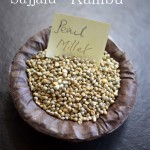 Pearl millet is widely cultivated type of millet. India is the largest producer of Pearl millet. This millet is an excellent source of phosphorus which is essential for the structure of body cells. The intake of Pearl millet helps to minimize the chances of type 2 diabetes. As it is a great source of magnesium, Millet is cofactor in the enzymatic reactions.
Pearl millet is widely cultivated type of millet. India is the largest producer of Pearl millet. This millet is an excellent source of phosphorus which is essential for the structure of body cells. The intake of Pearl millet helps to minimize the chances of type 2 diabetes. As it is a great source of magnesium, Millet is cofactor in the enzymatic reactions.
2. Finger Millet | Nachani | Kezhvaragu
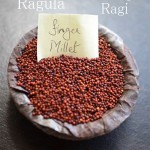 It is also called African finger millet, ragi and red millet. It is well known in Southern India. This millet is rich in protein and calcium with good source of iron and other minerals as well. Ragi has high amount of antioxidants and essential Amino Acids (EAA) which are vital for the human body.
It is also called African finger millet, ragi and red millet. It is well known in Southern India. This millet is rich in protein and calcium with good source of iron and other minerals as well. Ragi has high amount of antioxidants and essential Amino Acids (EAA) which are vital for the human body.
3.Foxtail Millet | Kangni | Thinai
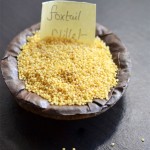 Foxtail millets are rich in iron and pest-free. Foxtail acts as anti pest agents which helps to store the delicate pulses like green gram. It controls the level of blood sugar and cholesterol levels and raise HDL cholesterol.
Foxtail millets are rich in iron and pest-free. Foxtail acts as anti pest agents which helps to store the delicate pulses like green gram. It controls the level of blood sugar and cholesterol levels and raise HDL cholesterol.
4. Kodo Millet | Kodra | Varagu
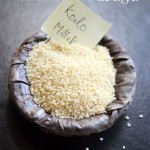 Kodo millet contains high amount of polyphenols which acts as an antioxidants. it is rich in in fiber and low on fat. Kodo millet inhibits glycation as well as cross linking of collagen. It is helpful for diabetes.
Kodo millet contains high amount of polyphenols which acts as an antioxidants. it is rich in in fiber and low on fat. Kodo millet inhibits glycation as well as cross linking of collagen. It is helpful for diabetes.
5. Little Millet | Kutki | Saamai
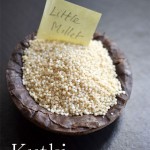 The seeds are smaller in comparison to other millet such as foxtail millet. Little millet has high amount of iron content and fiber like Kodo. It is rich in antioxidant properties. It is helpful for diabetes and stomach ailments.
The seeds are smaller in comparison to other millet such as foxtail millet. Little millet has high amount of iron content and fiber like Kodo. It is rich in antioxidant properties. It is helpful for diabetes and stomach ailments.
6. Barnyard Millet | Jhangora | Kuthiravali
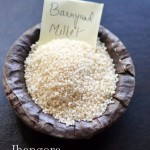 Barnyard millets are good source of fiber, phosphorous as well as calcium. Bardyard is low in glycemic index and assist the type 2 diabetes and cardiovascular ailments with its daily intake.
Barnyard millets are good source of fiber, phosphorous as well as calcium. Bardyard is low in glycemic index and assist the type 2 diabetes and cardiovascular ailments with its daily intake.
7. Sorghum | Jowar | Cholam
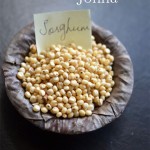 Sorghum is mostly cultivated due to its high fodder value. Sorghum is rich in nutrients with high amount of protein, unsaturated fats, fiber and minerals such as phosphorus, calcium, potassium and iron. in addition, it is loaded with calories as well as macro nutrients. Sorghum helps to promote metabolism.
Sorghum is mostly cultivated due to its high fodder value. Sorghum is rich in nutrients with high amount of protein, unsaturated fats, fiber and minerals such as phosphorus, calcium, potassium and iron. in addition, it is loaded with calories as well as macro nutrients. Sorghum helps to promote metabolism.
8. Proso millet
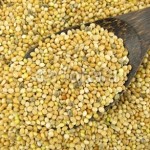 Proso millet is also called typical millet, white millet or hog millet . The wild ancestor and cultivation site of Proso millet are not known. Yellow proso is found in the packaged form or in the bulk bins at health food stores.
Proso millet is also called typical millet, white millet or hog millet . The wild ancestor and cultivation site of Proso millet are not known. Yellow proso is found in the packaged form or in the bulk bins at health food stores.
Recipe of Millet
1. Millet Muffins
Ingredients
- 2 1/4 cups whole wheat flour
- 1/3 cup millet
- 1 teaspoon baking powder
- 1 teaspoon baking soda
- 1 teaspoon salt
- 1 cup buttermilk
- 1 egg, lightly beaten
- 1/2 cup vegetable oil
- 1/2 cup honey
Directions
- Heat oven up to 400 degrees F. Grease sixteen muffin cups. In a bowl, mix wheat flour, millet flour, baking soda, baking powder and salt. In a separate bowl, mix buttermilk, vegetable oil, egg and honey. Then stir buttermilk mixture in a flour mixture until it is evenly moist. Put batter on prepared muffin cups.
- Bake for about 15 minutes within preheated oven or till a toothpick inserted in the center of the muffin becomes clean.
2. Millet Pie
It could be serve with ketchup, onion chutney and fruit.
Ingredients:
Original recipe makes 8 servings
- 1 cup water
- 1 cup oats
- 1 1/2 cups water
- 1 cup millet
- 1/2 cup diced onion
- 1/2 cup diced carrot
- 1/2 cup diced celery
- 1/2 cup diced potato
- 1/4 cup safflower oil
- 1/4 cup tamari sauce
- 1 teaspoon ground allspice
- 1/4 teaspoon ground nutmeg
- 4 whole cloves
- salt and ground black pepper to taste
- 1 recipe pastry for a 9-inch double crust pie
- 1 egg, beaten (optional)
Directions
- Boil one cup of water and oats in a saucepan. Reduce heat and simmer until the water is absorbed for about 10 minutes. Boil 1 1/2 cups water and millet in an individual saucepan. Lower heat and simmer until the water is absorbed and millet becomes to tender for about 20 minutes.
- Heat oven to 350 degrees F or 175 degrees C.
- Mix oats, onion, millet, celery, carrot, potato, tamari, safflower oil, nutmeg, allspice, cloves, salt and black pepper in a large bowl.
- Press one pie crust pastry in a nine inch pie pan. Pour the filling into pie crust. Top with second pie crust pastry. Then pinch an edges together. The top crust should be pierce to permit pie in order to ventilate during baking. Brush the top crust with the beaten egg.
- Bake the pie in the preheated oven until the crust becomes golden brown for about 40 minutes.
3. Baked Grains Pilaf
Ingredients
Original recipe makes 8 servings
- 1 tablespoon vegetable oil
- 1 onion, chopped
- 3 stalks celery, chopped
- 1/2 cup chopped bell pepper
- 1/2 cup corn kernels
- 3/4 cup millet
- 3/4 cup quinoa
- 1 teaspoon salt
- 3 cups low-sodium chicken stock
Directions
- Heat oven to 350 degrees F or 175 degree C.
- Add oil in skillet in medium heat. Cook and stir an onion, bell pepper, celery and corn in a hot oil until soften for about 10 minutes.
- Mix onion, quinoa, millet and salt in 8 x 8 inch casserole dish. Then pour in a chicken stock. Cover a dish with an aluminum foil.
- Then bake within a preheated oven until the grains become to tender and the liquid is absorbed for about 30 minutes.
References:
http://plants.usda.gov/core/profile?symbol=PAMI2
http://www.hear.org/pier/species/panicum_miliaceum.htm
http://davesgarden.com/guides/pf/go/31785/
http://www.pfaf.org/user/Plant.aspx?LatinName=Panicum+miliaceum
https://npgsweb.ars-grin.gov/gringlobal/taxonomydetail.aspx?id=26567
http://www.thehealthyhomeeconomist.com/beware-of-millet/
http://healthyeating.sfgate.com/eat-millet-breakfast-5272.html
http://www.care2.com/greenliving/12-health-benefits-of-millet.html
http://www.softschools.com/facts/plants/millet_facts/1093/
http://www.theresearchpedia.com/health/superfoods/health-benefits-proso-millet
Comments
| Millet Quick Facts | |
|---|---|
| Name: | Millet |
| Scientific Name: | Panicum miliaceum |
| Origin | Asia |
| Colors | Glabrous, white to reddish brown (Grain) |
| Shapes | Length: 3 mm long, ovoid or broad ellipsoid (Grain) |
| Taste | Mild sweet |
| Calories | 756 Kcal./cup |
| Major nutrients | Copper (166.67%) Manganese (141.91%) Carbohydrate (112.08%) Phosphorus (81.43%) Leucine (75.76%) |
| Health benefits | Healthy heart, Balance cholesterol level, Prevent diabetes, Assist digestion, Prevent cancer |
| More facts about Millet | |
| Rank | Scientific Name & (Common Name) |
|---|---|
| Kingdom | Plantae (Plants) |
| Subkingdom | Tracheobionta (Vascular plants) |
| Superdivision | Spermatophyta (Seed plants) |
| Division | Magnoliophyta (Flowering plants) |
| Class | Liliopsida (Monocotyledons) |
| Subclass | Commelinidae |
| Order | Cyperales |
| Family | Poaceae/Gramineae (Grass family) |
| Genus | Panicum L. (Panicgrass) |
| Species | Panicum miliaceum L. (Proso millet) |
| Synonyms |
|


